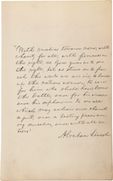At a Glance
Topics
Features
Duration
Grade(s)
Lesson Format
Download
Abraham Lincoln and the Jews
Students analyze letters, speeches, and other manuscripts to better understand how Abraham Lincoln interacted with Jewish Americans in a time of heightened anti-Semitism.
Review

In this engaging teaching module from the Shapell Manuscript Foundation in collaboration with the Roy Rosenzweig Center for History and New Media teachers are provided resources to help students better understand how Lincoln governed as president and the role of religion during the Civil War. Students will engage with primary sources including rare letters by Lincoln that are part of the Shapell collection. Other primary sources include letters by Civil War generals including Benjamin Butler, George McClellan, and William Tecumseh Sherman which demonstrate the anti-semitic attitudes held by many at the time.
Students work in groups to analyze sources with the goal of creating an exhibit that addresses the compelling question "What were Abraham Lincoln’s attitudes toward religious minorities such as Jews and Catholics and how did it differ from others at the time?" Teachers have the option of assigning students to create physical exhibits or digital exhibits on their topic. Students will also be asked to consider the context of nativist attitudes as expressed by group's such as the Know Nothing Party. An optional extension for the lesson is to have students read the Gettysburg Address to find connections between Lincoln's ideas in that text and in the manuscript sources they have analyzed. The modules also contain guidance on differentiation for diverse learners and connections to standards
Notes
| Field | Criteria | Comments | ||
|---|---|---|---|---|
| Historical Content | Is historically accurate? | Yes |
||
| Includes historical background? | Yes |
|||
| Requires students to read and write? | Yes. Sources are handwritten but transcriptions are available on the Shapell.org site. |
|||
| Analytic Thinking | Requires students to analyze or construct interpretations using evidence? | Yes |
||
| Requires close reading and attention to source information? | Yes |
|||
| Scaffolding | Is appropriate for stated audience? | Yes |
||
| Includes materials and strategies for scaffolding and supporting student thinking? | Yes |
|||
| Lesson Structure | Includes assessment criteria and strategies that focus on historical understanding? | Yes |
||
| Defines clear learning goals and progresses logically? | Yes |
|||
| Includes clear directions and is realistic in normal classroom settings? | Yes |
|||